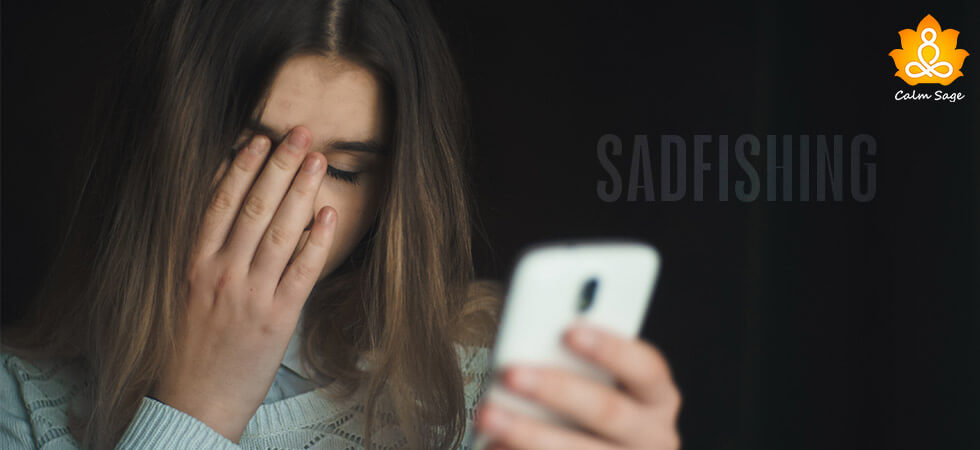Is ‘Sadfishing’ A Toxic Social Media Trend Or A Genuine Cry For Help?

You’ve probably seen on your social media feeds the type of posts that compels you to show your love and support. The ones where someone you know posts a sad selfie or a few lines where they express how sad and miserable they are feeling. Get me?
Now, these kinds of posts automatically (or more like instinctually) compel you to offer your support and sympathy. However, how much of what is being posted is true?
This social media trend is called ‘sadfishing’. While it’s not an official diagnosis or a term, it can still be used to describe the attention-seeking behavior of a teen or a young adult to “fish ” for sympathy, likes, comments, and followers.
More often than not, sadfishing can be an attention-seeking behavior but sometimes, it can be more than that. It can be a cry for help. In this article, let’s explore what catfishing is sadfishing, how you can spot sadfishing, the risks associated with this trend, and how to deal with sadfishing.
What Is Sadfishing?
Sadfishing is a term first coined by Rebecca Reid, a journalist. Rebecca described sadfishing as an attempt to “fish” for sympathetic reactions and comments by posting sad stories and images. In 2019, Kendall Jenner posted on her Instagram about having acne. And while she received a lot of sympathy from her fans and community, later, it was revealed that her post was a part of an advertising campaign for acne medication.
This incident gave birth to the term, ‘sadfishing’. In other words, this term can be described as making exaggerated (and vague) claims online to gain attention, support, and sympathy.
Nonetheless, not all social media posts (especially the sad and vague ones) are inauthentic. Sometimes, a person may post something emotional not to gain sympathy and attention but to increase awareness and seek help.
Another problem that occurs when we talk about social behavior online and sadfishing are that most emotional posts (to be considered sadfishing) are posted by teens and young adults. In today’s world, teens are learning how to express themselves, and to do that they use social media.
Trust me, there’s nothing wrong with a teen or a young adult posting about their struggles online or raising awareness on an issue. Yet, it’s still a significant struggle to predict how their followers and online friends will react or interpret their struggles. Sometimes, they will receive support, love, and all that’s positive whereas other times, they might receive negative comments and reactions, accusing them of sadfishing.
So, how do you spot sadfishing enough to differentiate between attention-seeking behavior and a genuine cry for help?
Is It Sadfishing Or A Cry For Help?
As a parent of a teenager, it can be an issue in determining when your child is being true and open about their feelings and experiences and when they are simply seeking attention. Social media can be a great online tool to find support for many mental and emotional health problems but at the same time, it can be an unsafe space for a teen.
It can be hard to understand the context and non-verbal cues when you’re online. There’s no way to accurately determine if a person is genuinely emotional or is seeking sympathy, especially when you can’t talk to them face-to-face.
Psychologist Amy Morin says that sadfishing can be a sign of a teen craving attention. She adds,
“They may be lacking positive attention from their peers. Or, they may be hurting and unsure how to communicate their needs effectively. It might also be their attempt to test others’ loyalty so they can see who cares about them based on how other people respond.”
There are some warning signs that you can look out for when wondering if your teen is sadfishing or needs help. For example, they may make statements such as:
- “Everyone would be better off if I’m not in the picture”
- “Life is hopeless”
- “There is nothing to look forward to anymore”
These examples of sadfishing can be a warning sign that the one posting such comments might be considering self-harm or might have thought of committing suicide. Other warning signs may include:
- Signs of depression
- Intense feelings of hopelessness
- Thinking too much about death
- Intense feelings of being worthless
- Feeling trapped
Another sign that your child needs help can be; when they are not socially active (online) but suddenly starts writing emotional posts or sharing something dramatic. If this happens, it can sign that they might need help.
Sadfishing And Its Mental Health Implications
In a survey conducted in the UK, it was found that sadfishing can make it difficult for people, especially teens struggling with poor mental health to find support online.
In this research, in-person interviews were conducted with over 50K teens (aged 11-16) where the majority of them reported experiencing cyberbullying or receiving negative responses to their posts on emotional struggles or vulnerability.
Other times, they ended up not receiving any support and that caused them to stop making posts at all.
In another study, a link between social media use and mental health indicated that spending time on social media affects one’s mood and increases the symptoms of depression, anxiety, and loneliness.
In another survey, it was found that teens and young adults who made emotional posts online were more at risk of being targeted by online predators. These online predators often look for vulnerable posts and will attempt to make connections with the teen in the pretense of offering support, only to later exploit the information shared.
Other concerns that sad fishing can lead to include:
- Feelings of loneliness
- FOMO
- Self-harm
- Suicidal thoughts
How To Deal with Sadfishing?
As a parent, the first thing you can do is talk to your teen and their social media habits. You can also ask them how they are feeling and what they are thinking about.
Try to establish a connection with them where they feel safe and comfortable opening up to you. Listen to their concerns without judgment or trying to “fix” them. Instead, you can respond with empathetic statements such as,
- “I understand what you’re feeling”
- “What you’re going through sounds hard”
As a parent, you need to make sure you don’t minimize or invalidate their feelings or experiences. Avoid using statements such as, “What you’re going through isn’t that hard”. These statements can hurt your child and may cause them to shut you out.
Because social media is something everyone uses, it is important to remind your teen to be careful and mindful of the information they post online. You need to make sure they understand that not everyone who will read or watch what they post will be received well and positively.
It’s also important for a parent to talk to their teens about identifying their emotions and where to seek help when they struggle with said emotions. Teach them where to post emotional posts online such as in a local community group, online support groups, chat forums, etc. where they can share their feelings and get the right support.
You can also connect your child with a mental health professional so that they receive the right help and learn how to deal with the problems they are struggling with using healthy coping methods.
Wrap Up
Social media can be a social diary for teenagers and young adults when they feel the need to share their feelings and/or experiences with their peers or when their feelings become too overwhelming to keep bottled up.
Sadly, sadfishing can interfere with the genuine need to seek help. As a parent, you can teach your child the importance of where, how, and what to share on social media and other platforms to avoid negative responses and being accused of sadfishing.
You (as a parent) mustn’t forbid them to use social media. For teens, social media is an effective tool to connect with their peers and even find support online. Preventing them from using social media is not effective. However, you can teach them the importance of setting digital boundaries and how to use social media responsibly.
I hope this blog helped you understand what sadfishing is and how it can be harmful to teens and young adults. For more, you can write to us at info@calmsage.com or DM us on social media if you’re looking for support.
You can also share your thoughts on sadfishing and its mental health impact with us in the comments below!
Take Care!




















